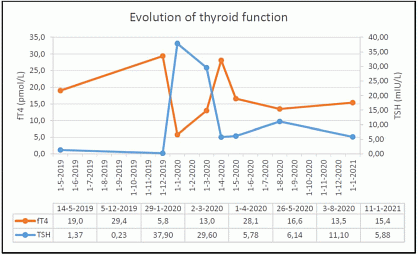BES2021 Belgian Endocrine Society 2021 Abstracts (26 abstracts)
HLA-DR4/DR13 in a patient with durvalumab-induced thyroiditis
de Filette , Jeroen M.K 1 , De Rop Jonas 1 , André Stéphanie 2,3,4 , De Mey Lynn 5 , Aspeslagh Sandrine 6 , Karmali Rafik 7 , Van der Auwera Bart J 8 & Bravenboer Bert 1
1Department of Endocrinology, UZ Brussel, Laarbeeklaan 101, 1090 Brussels, Belgium; 2Department of Pulmonary Medicine, Saint-Pierre University Hospital, Rue Haute 322, 1000, Brussels, Belgium; 3Université Libre de Bruxelles, Brussels, Belgium; 4Department of Pulmonary Medicine, Brugmann University Hospital, Brussels, Belgium; 5Vrije Universiteit Brussel, Laarbeeklaan 103, 1090 Brussels, Belgium; 6Department of Medical Oncology, UZ Brussel, Laarbeeklaan 101, 1090 Brussels, Belgium; 7 Department of Endocrinology, CHU Brugmann Université Libre de Bruxelles, Brussels Belgium; 8 Diabetes Research Center, Vrije Universiteit, Brussel, Brussels, Belgium;
Background: Immune checkpoint inhibitors (ICI) targeting cytotoxic T-lymphocyte-associated protein 4 (CTLA-4), programmed cell death protein 1 and its ligand (PD-1/PD-L1) are the current standard-of-care for many advanced cancers (1). This novel therapeutic approach comes with its costs in the form of immune-related adverse events (irAE). The underlying mechanisms are not yet fully understood. We explore the role of HLA in endocrinopathy related to ICI therapy using an interesting patient.
Case presentation: A 63-year-old woman was diagnosed in May 2019 with stage IIIB non-small cell lung carcinoma of the right superior lobe with PD-L1 expression > 50%. The patient had a partial therapeutic response on two cycles of radio-chemotherapy with carboplatin and vinorelbine, with persistence of mild hypermetabolism in pulmonary nodules. She was started on consolidation immunotherapy with durvalumab (anti-PD-L1), 10 mg/kg every two weeks, with the intended treatment duration of one year. A routine blood sampling performed before the first chemotherapy showed normal thyroid function with a TSH 1.37 mU/L (reference range: 0.27-4.20) and free T4 19.0 pmol/l (reference range: 12.0-22.0). The thyroid function was not rechecked before the first durvalumab dosing. In December 2019, after three cycles, the patient presented herself at the pneumology department with fatigue, weight loss (2 kg in two months) and increased shortness of breath. Laboratory analysis showed a mild hyperthyroidism with decreased TSH (0.23 mU/L) and increased free T4 (29.4 pmol/l). Approximately 6 weeks later, levothyroxine 50 mg daily was started because of an evolution towards hypothyroidism (with TSH 37.90 mU/L; free T4 5.8 pmol/l), as shown in Figure 1. Thyroperoxidase antibodies were positive (216 kUI/L, reference range: < 34), while the TSH receptor antibodies (TRAb, analysis of stimulating and blocking) were negative. Ultrasound examination of the thyroid was normal. Thyroid scintigraphy was not performed. HLA analysis showed A*02, -; B*15,*40; C*03,*07; the DR haplotypes: DRB1*04,*13, and the DQ haplotypes: DQB1*03,*06.
Discussion: This case report illustrates that more attention should be given to the immunogenetic background of oncology patients treated with immunotherapy (2). HLA polymorphisms have been implicated for ‘conventional’ autoimmune thyroid disease (AITD), such as DR4 (susceptible), DR7 and DR13 (protective) for Hashimoto, and DR3 (susceptible) for Graves’ disease. Our patient has a mixed HLA susceptibility, with the presence of both HLA-DR4 (susceptible) and DR13 (protective). A variety fo other HLA associations have been described in patients with endocrinopathy related to immune therapy, such as DR4 in diabetes mellitus; DR4-DQ4 and DR9-DQ9 in diabetes mellitus of Asian origin (3); HLA-A2, A24, B7, DR1 and DR4 (lymphocytic hypophysitis) in two cases of nivolumab-induced hypophysitis, DRB1*04 : 05-DQA1*03 :03-DQB1*04 :01 (autoimmune polyglandular syndrome with pituitary disorder in a Japanese population) in a patient with isolated adrenocorticotropin deficiency by nivolumab-induced hypophysitis.
Conclusion: In summary, our case of patient with thyroiditis associated with the PD-L1 inhibitor durvalumab highlights not only the need for proactive monitoring of thyroid function, but also identifying biomarkers associated with an increased risk of ICI-induced side effects for better patient selection, optimal management and improved understanding of the mechanisms involved.
References: 1. Sammamed MF, Chen L. A Paradigm Shift in Cancer Immunotherapy : From Enhancement to Normalization. Cell. 2018.
2. Correale P, Saladino RE, Nardone V, Giannicola R, Agostino R, Pirtoli L, et al. Could PD-1/PDL1 immune checkpoints be linked to HLA signature ? Immunotherapy. 2019.
3. De Filette JMK, Pen JJ, Decoster L, Vissers T, Bravenboer B, Van Der Auwera BJ, et al. Immune checkpoint inhibitors and type 1 diabetes mellitus : A case report and systematic review. European Journal of Endocrinology. 2019.
 }
}



